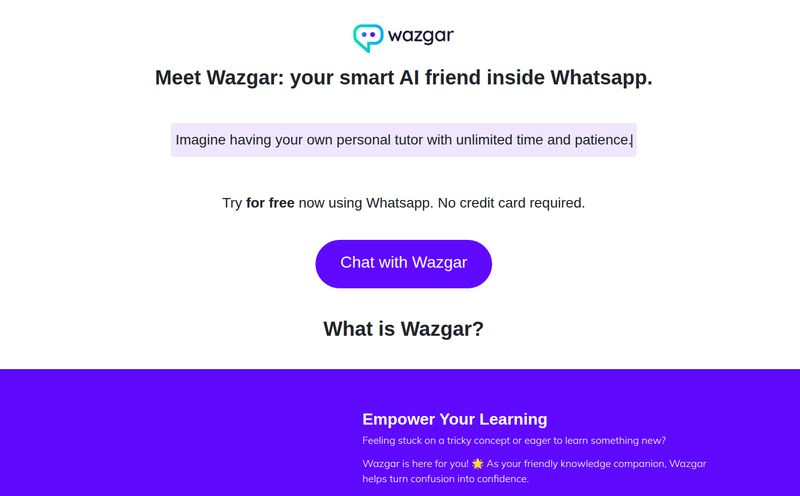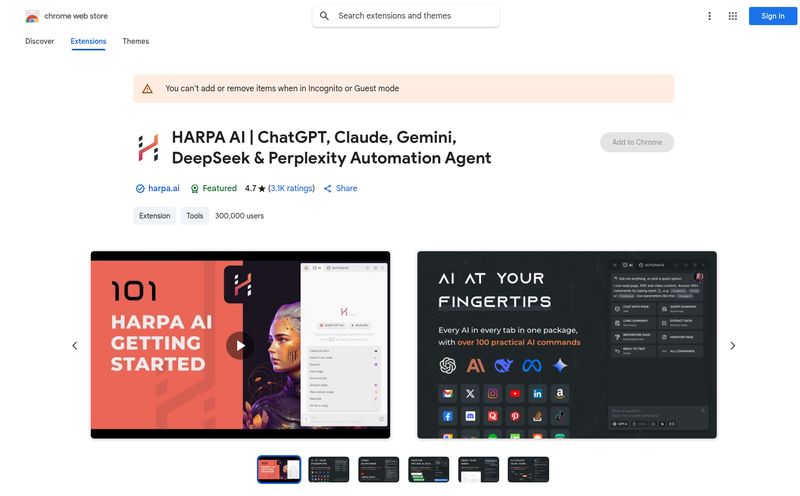We’ve all been there. You have a simple question about a product. You land on the company’s website, hunt for the “Help” or “FAQ” link, and are greeted by a wall of text that looks like it hasn’t been updated since 2011. You hit CTRL+F, type in your keyword, and get zero results. Ugh. Your only options left are to fill out a contact form and wait 48 hours for a reply or dive into the soul-crushing labyrinth of a phone support system.
It’s a terrible customer experience. We know it. Companies know it. For years, the FAQ page has been a necessary evil, a digital graveyard where questions go to be ignored. But what if it didn’t have to be that way? With the absolute explosion of AI tools in every corner of the marketing and business world, I’ve been keeping my eye out for something that actually solves this problem. And that's how I stumbled upon a tool called InFAQ.
The name itself is clever, I'll give them that. But does it live up to the promise of revolutionizing the dusty old FAQ page? Let's get into it.
What Exactly is InFAQ Supposed to Do?
So, at its core, InFAQ isn't just a static page builder. That’s the first thing to get your head around. It's an AI-powered tool designed to create an interactive FAQ experience. Think of it less like a digital manual and more like a knowledgeable, 24/7 salesperson who has had way too much coffee and is eager to help.
The whole idea is to stop making customers dig for information. When a user has a question, they can just… ask it. In plain language. The AI then parses the question and provides an instant answer based on the information you've fed it. It's meant to declutter your website and give your customers a straight path to the answers they need, which, in the world of CPC and traffic generation, is gold. Every second a potential customer spends frustrated is a second they're closer to bouncing.

Visit InFAQ
The Core Features That Caught My Eye
Okay, the concept is cool. But as any seasoned SEO or digital marketer knows, concepts are cheap. Execution is everything. I dug into InFAQ's feature set to see what’s really under the hood.
More Than Just Answers: AI-Powered Conversations
The main event is obviously the AI question-answering. This is what separates it from a glorified search bar. A user can ask “What’s your return policy for items bought on sale?” and the AI is smart enough to understand the intent and find the right piece of information. This is a huge leap from keyword-matching systems that would probably just show every result containing the word “sale”. It’s about understanding context, which is the holy grail of user interaction.
Guiding Users, Not Just Responding
This is where things get interesting for us marketing folks. InFAQ doesn't just answer a question and call it a day. It can also provide relevant link suggestions. So, if a customer asks about the specifications of a certain product, the AI can answer the question and provide a direct link to that product's sales page. Or better yet, a link to a higher-tier product. They call this a “conversion and upsell capability,” and I call it smart business. It turns a support interaction into a sales opportunity, which is a fantastic way to improve ROI on a support tool.
The Dream of Automated Support
I remember my early days running a small e-commerce site. I swear, 80% of my emails were the same three questions over and over. “Where is my order?”, “Do you ship to Canada?”, and “Can I get a discount?”. Automating that would have saved me hours every single day. That's the promise here—to reduce the customer support workload by handling the first line of defense. This frees up your human support team to deal with the complex, nuanced issues that actually require a human touch.
Let's Talk Money: InFAQ Pricing Breakdown
Alright, no tool is perfect if the price is wrong. I was pleasantly surprised to see a tiered structure that seems to cater to different business sizes. It's not one of those scary “Contact Us for a Demo” enterprise-only models. Here's how it breaks down, based on their yearly billing cycle:
| Plan | Price (Billed Yearly) | Key Features & Limits |
|---|---|---|
| Starter | $15 /month | 20 FAQs, 100 credits/mo |
| Premium | $39 /month | 40 FAQs, 200 credits/mo |
| Enterprise One | $79 /month | 2 InFAQs, 50 FAQs/InFAQ, 500 credits/mo, Pro Analytics, Hallucination Guard |
The Starter plan seems perfect for a small blog or a new e-commerce store. The “credits” likely refer to the number of AI-powered queries per month, and 100 is a decent starting point. The jump to Premium doubles your FAQs and credits for a reasonable price. But that Enterprise One plan... that's where the seriously cool stuff is. “Pro Analytics” is a given, but the “Hallucination Guard” is what really stands out. This is a direct acknowledgement of one of the biggest problems with current AI models – their tendency to make stuff up. Building a feature to combat that shows a level of self-awareness I respect.
The Good, The Bad, and The AI-Generated
No review is complete without a brutally honest look at both sides of the coin. No tool is a magic wand.
On the plus side, the potential to improve customer experience is massive. Instant answers mean happy customers, and happy customers convert better. The ability to reduce the strain on your support team is also a huge win. For any growing business, that's a tangible benefit that saves both time and money. It's also dead simple to grasp the concept, which is a big plus.
But, okay, let’s get real. The tool’s effectiveness is completely dependent on you. The old saying “Garbage In, Garbage Out” has never been more true. If your initial set of FAQs is poorly written, incomplete, or out of date, the AI will just serve up bad information with confidence. So, there's an initial setup burden. You have to sit down and create a high-quality knowledge base for the AI to learn from. Furthermore, it's not a set-it-and-forget-it platform. Products change, policies evolve. You'll need to perform ongoing maintenance to keep the information fresh. Its effectiveness is tied directly to the quality of your input.
Who is This Tool Actually For?
I can see a few clear winners here. The scrappy e-commerce store owner is a prime candidate. Anyone selling products online gets flooded with repetitive questions, and this could be a lifesaver. SaaS companies are another big one; they could use InFAQ to handle common onboarding questions or technical queries, improving user activation and retention. I could even see larger companies using it for internal purposes—an AI-powered knowledge base for HR policies or IT troubleshooting could be incredibly useful and cut down on so much wasted time.
A Quick Comparison to the Old Way
Let's just quickly stack this up. Compared to a traditional, static FAQ page, it's a no-brainer. One is a digital document, the other is an interactive assistant. Night and day.
Compared to a live chat widget, it gets more interesting. Live chat is great for complex problems, but it's expensive to staff 24/7 and often comes with queue times. InFAQ handles the simple stuff instantly, anytime, without needing a human operator. I see it not as a replacement for live chat, but as a filter. It solves 80% of the queries, letting the truly difficult ones escalate to a real person. This creates a much more efficient support ecosystem.
My Final Thoughts on InFAQ
So, is InFAQ the silver bullet for all our customer support woes? No, of course not. But it’s a massive step in the right direction. It takes the concept of an FAQ from a passive, archaic document to an active, helpful part of your website's ecosystem. The potential to not only answer questions but also guide users toward conversions is a powerful combination.
The key is to go in with realistic expectations. It requires thoughtful setup and ongoing care. But for businesses drowning in repetitive support tickets or looking for a modern way to improve their customer experience without breaking the bank, InFAQ is a genuinely compelling option. It's a sign that we’re finally moving past the era of the static, unhelpful help page, and I, for one, am glad to see it go.
Frequently Asked Questions
- How hard is it to set up InFAQ?
- Based on the premise, the setup seems straightforward. The main work isn't technical; it's in writing and organizing the initial batch of high-quality questions and answers that you will feed into the system.
- What happens if the AI can't answer a question?
- While not explicitly stated, most systems like this have a fallback. It would likely provide a message like "I'm not sure how to answer that, please contact our support team here" and provide a link to a contact form or live chat, ensuring the customer isn't left at a dead end.
- How does the 'Hallucination Guard' likely work?
- This is an advanced feature, but it probably works by constraining the AI's responses strictly to the knowledge base you provide. It sets up guardrails to prevent the AI from making creative—but incorrect—inferences or pulling information from outside its designated data set.
- Can I use InFAQ for something other than customer support?
- Absolutely. You could use it to create an internal knowledge base for employees, a study guide for students based on course materials, or a product information tool for a sales team. The application is as flexible as the information you provide.
- Is the pricing per month or per year?
- The advertised prices ($15, $39, $79) are the monthly cost, but they are based on being "billed yearly." This means you'd pay for the full year upfront (e.g., $15 x 12 = $180 for the Starter plan).



